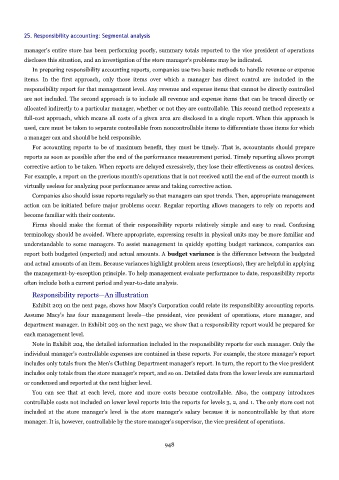Page 947 - Accounting Principles (A Business Perspective)
P. 947
25. Responsibility accounting: Segmental analysis
manager's entire store has been performing poorly, summary totals reported to the vice president of operations
discloses this situation, and an investigation of the store manager's problems may be indicated.
In preparing responsibility accounting reports, companies use two basic methods to handle revenue or expense
items. In the first approach, only those items over which a manager has direct control are included in the
responsibility report for that management level. Any revenue and expense items that cannot be directly controlled
are not included. The second approach is to include all revenue and expense items that can be traced directly or
allocated indirectly to a particular manager, whether or not they are controllable. This second method represents a
full-cost approach, which means all costs of a given area are disclosed in a single report. When this approach is
used, care must be taken to separate controllable from noncontrollable items to differentiate those items for which
a manager can and should be held responsible.
For accounting reports to be of maximum benefit, they must be timely. That is, accountants should prepare
reports as soon as possible after the end of the performance measurement period. Timely reporting allows prompt
corrective action to be taken. When reports are delayed excessively, they lose their effectiveness as control devices.
For example, a report on the previous month's operations that is not received until the end of the current month is
virtually useless for analyzing poor performance areas and taking corrective action.
Companies also should issue reports regularly so that managers can spot trends. Then, appropriate management
action can be initiated before major problems occur. Regular reporting allows managers to rely on reports and
become familiar with their contents.
Firms should make the format of their responsibility reports relatively simple and easy to read. Confusing
terminology should be avoided. Where appropriate, expressing results in physical units may be more familiar and
understandable to some managers. To assist management in quickly spotting budget variances, companies can
report both budgeted (expected) and actual amounts. A budget variance is the difference between the budgeted
and actual amounts of an item. Because variances highlight problem areas (exceptions), they are helpful in applying
the management-by-exception principle. To help management evaluate performance to date, responsibility reports
often include both a current period and year-to-date analysis.
Responsibility reports—An illustration
Exhibit 203 on the next page, shows how Macy's Corporation could relate its responsibility accounting reports.
Assume Macy's has four management levels—the president, vice president of operations, store manager, and
department manager. In Exhibit 203 on the next page, we show that a responsibility report would be prepared for
each management level.
Note in Exhibit 204, the detailed information included in the responsibility reports for each manager. Only the
individual manager's controllable expenses are contained in these reports. For example, the store manager's report
includes only totals from the Men's Clothing Department manager's report. In turn, the report to the vice president
includes only totals from the store manager's report, and so on. Detailed data from the lower levels are summarized
or condensed and reported at the next higher level.
You can see that at each level, more and more costs become controllable. Also, the company introduces
controllable costs not included on lower level reports into the reports for levels 3, 2, and 1. The only store cost not
included at the store manager's level is the store manager's salary because it is noncontrollable by that store
manager. It is, however, controllable by the store manager's supervisor, the vice president of operations.
948

